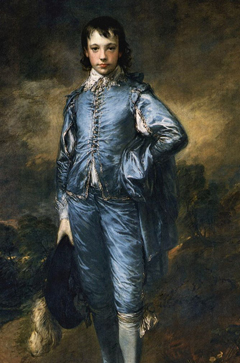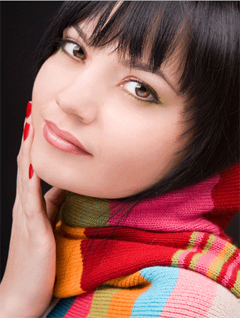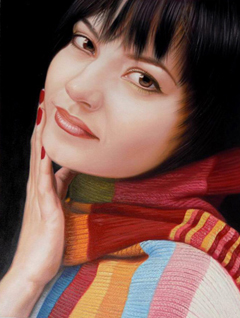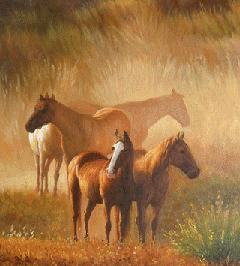| PAINTING FROM A PHOTOGRAPH |
 |
|
Artists have been painting from photographs for as long as photographs have existed. Not only is this an excellent way to perfect a realistic style, but it allows the artist to add a unique, personal touch and a feeling of timelessness to a favorite image.
The term "Photorealism" was coined by an American art dealer in the 1960s, to describe a painting style that replicates a source photograph in extreme detail, to the point that the finished painting is virtually indistinguishable from the original image.
As laid out in the definition of the style, and by general necessity, photorealism requires a "mechanical" process: using a projector or transfer paper to trace the image onto the painting surface, or creating a grid on both the photo and the painting surface and accurately copying each section.
In this article, we examine these methods of recreating a photograph as a painting. We will also discuss our exciting Handmade Oil Painting service.
|
SUMMARY
| GRID TRANSFER |
PROJECTOR TRANSFER |
TRANSFER PAPER |
THE PAINTING PROCESS |
HANDMADE OIL PAINTINGS |
| A grid is drawn on both the source image and the painting surface. The image recreated box by box. |
The source is projected onto the painting surface (often on the wall) and traced. |
The source is placed over the transfer paper, which is placed face down on the canvas. When the source image is traced, the lines press the graphite in the tranfer paper onto the canvas. |
Once the basic outline is transferred, the most difficult part - the painting - begins. |
At KeenART Media, we offer handmade, oil painted replicas of your favorite photograh, created by experienced artists. |
|
| TRANSFERRING A PHOTO USING A GRID
|
 |
|
If you took art classes in elementary and high school, it's quite likely you have dabbled in this method yourself.
Grid-based paintings are almost always copies of an existing image. They are useful for getting details, perspectives and relationships right, and also for making a copy of a photograph larger or smaller than the original.
- First, a grid is drawn on the surface of the original photograph. Alternately, if the image is digital, a grid can be placed using a program like Photoshop. This image can then be printed, or just copied from the screen.
- Next, a grid is created on the painting substrate, be it canvas, paper, or another material. Depending on the media used to create the artwork, this grid may be physically drawn on the surface using a pencil, or a separate grid can be placed behind the material; a lighting board can then illuminate the papers, making the grid visible on the painting surface.
The media matters here, because a grid drawn directly on the paper isn't ideal if the finished piece will be a pencil drawing. In this case, a grid behind and showing through is best. However, if the finished piece will be a colorful acrylic painting, the pencil lines will not be visible on the completed piece.
- Each grid - the one on the original and the one on the painting surface - must have the same number of boxes, with the same aspect ratio: square is ideal. The squares of the painting grid may be 1" x 1", while the original squares are 1/2" x 1/2" - this will result in a painting that is twice as large; if vice versa, a painting that is half as large.
- Now, the artist can begin transferring what appears in each box on the original into the corresponding box on the painting surface. In most cases, this step will be done in pencil. Later, when paint is added, a more overall method may be used.
By using a grid, the artist retains the pure originality of drawing the entire piece (as opposed to tracing), but can easily make sure everything is correct. It is much simpler to place a leaf in exactly the same spot as the original if they know it intersects a particular point on a small square, rather than trying to match it by approximation.
Grid-based paintings and drawings are useful for more than professionals creating photo-realistic images. They are an excellent way to learn to draw any image at all, particularly faces, where subtle changes in the face structure and placement of features can drastically alter the end result.
|

Each box will be painted separately on the blank canvas
|
| TRANSFERRING A PHOTO USING A PROJECTOR
|
 |
Another way to ensure the basis of the painting will be an exact replica of the original photograph is to use a projector.
- The photo is printed on a transparency or a slide, and a light box and mirror projector is used to direct the image at the painting substrate (often affixed to the wall).
This method allows the artist to choose the size of the painting without determining the grid size. Moving the projector closer to the wall will make the projected image larger; moving it away will make the projected image smaller.
- Once the correct size is achieved, the artist traces the basic lines of the image onto the painting surface.
- Once the whole image has been traced onto the painting surface, the photograph will still be used as a direct reference for creating the painting, but the relationship of the subjects, background, etc are already in place.
|

|
| TRANSFERRING A PHOTO USING TRANSFER PAPER
|
 |
|
This method is very similar to using a projector. Instead of creating a slide of the original, the artist uses transfer paper. Most people think of carbon when they imagine transfer paper, but a graphite version has been developed especially for this artistic purpose. Graphite washes off much more easily than carbon, and can be replaced.
- The artist attaches the graphite transfer paper to the painting substrate - the canvas or paper - with the chalky, graphite side down. The source photo is taped on top, right side out.
- Using a sharp-pointed tool like a pencil, the artist traces over the basic lines of the source photo, capturing the most important details. This also allows the artist to leave out anything they don't want included in the image.
- When the transfer paper and the source photo are removed from the canvas or paper, what remains is a copy of what the artist traced, in graphite (essentially - pencil). From there, the artist can begin to add color to the image.
Unlike the two methods mentioned above, the tracing paper method cannot be used to create a different sized painting than the original image. It is easy these days to make enlargements of photographs, however, letting the artist print the source photo in almost any size they want.
|

This graphite paper is placed between the image and the drawing paper
|
| AFTER THE IMAGE TRANSFER
|
 |
|
Once the artist has used any of the above methods to recreate the source image on the painting surface, the tricky part begins.
Even though the outline of the painting has been prepared, an artist must still have a lot of experience using their chosen media - oil paint, acrylic, charcoal, etc - in order to create an artwork that looks just like the source image. They must know how to blend colors to depict light and shadow, how to shade the image to make it appear three-dimensional on a two-dimensional surface, and the right brushes and paint densities.
The artist may apply many layers as they create the artwork, and the painting can go through many reincarnations before it looks just like the source photo.
|

This painting by Gilbert Stuart is highly recognizable as former President George Washington
|
| EXACT COPY VS. ORIGINAL PAINTING
|
 |
|
Sometimes an identical replica of an image is not what the customer wants. For instance, a recently married couple may supply their wedding photo and request that it be turned into a painting, but still look like a painting. This means the artist can have a bit of artistic license.
In this case, most artists will still use one of the above transfer methods, but can then be a bit freer with their brushstrokes and color choices. Detailed trees may become a blurred background, basic lighting may become dappled, and certain details may be left out if requested, though the faces of the couple will still be crisp and clear. Sometimes, artists recreate the background entirely, moving the subjects from a hall to a beach or open field.
The image to the right is "The Blue Boy" by Thomas Gainsborough. As you can see, the boy is depicted standing before a mounting scene in which a storm appears to be occurring. It is highly unlikely this child posed on a cliff. More probably, he was painted in a studio, and the background was then creatively designed by the artist, perhaps using an existing artwork as a reference.
|

|
| HANDMADE OIL PAINTINGS FROM KEENART MEDIA
|
 |
|
At KeenART Media, you can order a handmade oil painting created from your very own photograph in just a few easy steps!
- Select your photo. Wedding picture, snapshots from baby's first photo shoot, and scenes of favorite family destinations are all popular chocies, but any image that has meaning to you can be replicated in oil paint by the hand of a talented artist, for just a fraction of the price you'll find elsewhere.
Please select a good quality photograph, so the artist can clearly see the details they are to reproduce. If the photograph you want replicated does not clearly show the face or primary subject, you can supply another photograph of the same subject for the artist to use as reference, however, a single photo with high resolution and clarity will produce the best painting.
- Upload your photograph to our server. Select the size of the finished piece, and identify the number of figures in the image.
- Be sure to outline any changes - removing a line or background object, color changes, cropping - in the notes section supplied during the checkout process. If you do not identify any changes, the artist will assume you want an exact copy of the image.
Each artist has a slightly different style, so some handmade oil paintings may be indistinguishable from your photograph, while others may be slightly more "painterly." If you have a preference, please let us know and we will do our best to match your image to an artist who works in your desired style
- One of our talented artists will then create a one of a kind, 100% original painting on canvas, from your photograph. The artist creates your entire piece on a blank canvas using oil paints - these are not paintings on top of photographic prints.
MORE INFORMATION ON HANDMADE OIL PAINTINGS
- Because your oil painting is created entirely by hand, with care and artistic talent, this service cannot be offered with a two day turn around. Our handmade oil paintings take 2 - 3 weeks to complete. If a digital proof is required prior to completion, more time may be needed.
- We offer handmade oil paintings from existing images only. Unfortunately, we are not equipped to create paintings from textual description, or a variety of different photographs. The only exception to this is the use of a second portrait if the face in the primary photograph is not clear enough.
- Your handmade oil painting will be priced based on the finished size and the number of figures in the image. This is the "figure count" you will see listed below the drop down menus for the painting size. Select a figure count equal to the number of people in the image. If there are no people in the picture - if it is a mountain, car, or cabin, for instance - figure count refers to the number of objects in the foreground, including cars, houses, or artworks (ie: statues).
- The price for your handmade oil painting includes stretching on a 3/4" deep stretcher bar frame. If you would like to add a solid wood frame to your painting, please browse our selection of picture frame mouldings and canvas floater frames. If you are ordering a frame as well, please make a note in the supplied area, letting us know this frame is for your painting. That way we can make sure we fit it properly.
- We prefer to create paintings from a digital photograph. If you have a poster or old photograph, please contact us to discuss the best way to create your painting.
- It is the goal of our artists to create a painting as close to the original photograph as possible. That said, each artist has a slightly different style, which helps to create a completely unique, one-of-a-kind artwork. If you would like any painterly effects such as a blurred background or stylistic depiction of figures, or if you want your painting to look exactly like your photograph, please let us know in the note section of your order.
- If you would like an original painting of a famous masterpiece (such as Klimt's The Kiss, or Van Gogh's Sunflowers), we have a wide selection of images of paintings by classic artists. You may choose one of these, at no additional cost, to have hand painted. Please note: the same figure count applies to these paintings as to a photographic image.
|

The original photograph

The handmade oil painting

The original photograph

The handmade oil painting
|
|
Do you have a photograph that would look just stunning as a painting? Visit our Handmade Oil Paintings service page and place your order today, or just browse our gallery of finished oil paintings. These beautiful, one-of-a-kind canvas artworks are the perfect way to memorialize a special day or favorite spot, and make wonderful gifts, as well.
If you have any questions about our handmade oil paintings, or any of our other products or services, please don't hesitate to contact us. Our knowledgeable staff are always happy to offer answers and advice about our wide range of offerings.
(This article was partially researched using Art Is Fun website.)
|
|
© 2002-2026 - KeenART Media Ltd.
|
|
| |
|
